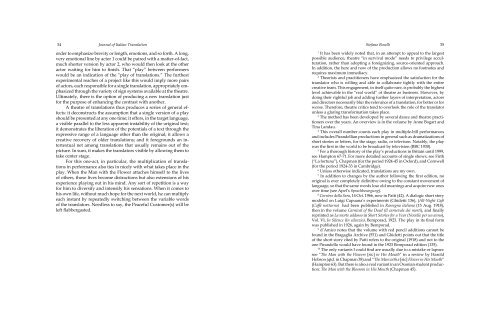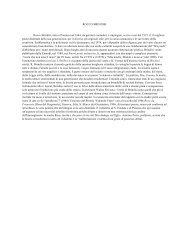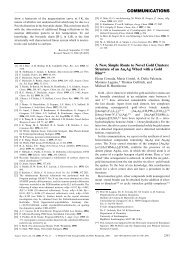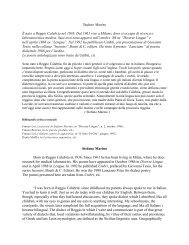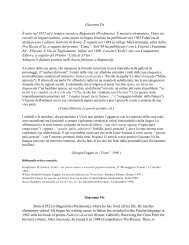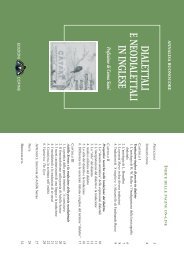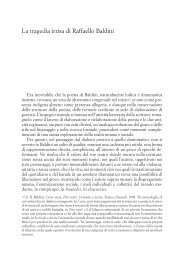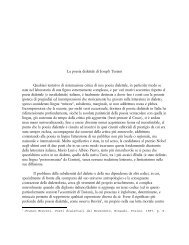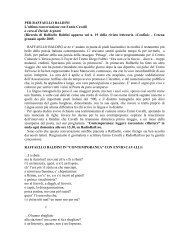Journal of Italian Translation - Brooklyn College - Academic Home ...
Journal of Italian Translation - Brooklyn College - Academic Home ...
Journal of Italian Translation - Brooklyn College - Academic Home ...
Create successful ePaper yourself
Turn your PDF publications into a flip-book with our unique Google optimized e-Paper software.
34 <strong>Journal</strong> <strong>of</strong> <strong>Italian</strong> <strong>Translation</strong><br />
Stefano Boselli<br />
35<br />
order to emphasize brevity or length, emotions, and so forth. A long,<br />
very emotional line by actor 1 could be paired with a matter-<strong>of</strong>-fact,<br />
much shorter version by actor 2, who would then look at the other<br />
actor waiting for him to finish. That “play” between performers<br />
would be an indication <strong>of</strong> the “play <strong>of</strong> translations.” The furthest<br />
experimental reaches <strong>of</strong> a project like this would imply more pairs<br />
<strong>of</strong> actors, each responsible for a single translation, appropriately emphasized<br />
through the variety <strong>of</strong> sign systems available at the theatre.<br />
Ultimately, there is the option <strong>of</strong> producing a new translation just<br />
for the purpose <strong>of</strong> enhancing the contrast with another.<br />
A theatre <strong>of</strong> translations thus produces a series <strong>of</strong> general effects:<br />
it deconstructs the assumption that a single version <strong>of</strong> a play<br />
should be presented at any one time; it <strong>of</strong>fers, in the target language,<br />
a visible parallel to the less apparent instability <strong>of</strong> the original text;<br />
it demonstrates the liberation <strong>of</strong> the potentials <strong>of</strong> a text through the<br />
expressive range <strong>of</strong> a language other than the original; it allows a<br />
creative recovery <strong>of</strong> older translations; and it foregrounds an intertextual<br />
net among translations that usually remains out <strong>of</strong> the<br />
picture. In sum, it makes the translators visible by allowing them to<br />
take center stage.<br />
For this one-act, in particular, the multiplication <strong>of</strong> translations<br />
in performance also ties in nicely with what takes place in the<br />
play. When the Man with the Flower attaches himself to the lives<br />
<strong>of</strong> others, those lives become distractions but also extensions <strong>of</strong> his<br />
experience playing out in his mind. Any sort <strong>of</strong> repetition is a way<br />
for him to diversify and intensify his sensations. When it comes to<br />
his own life, without much hope for the next world, he can multiply<br />
each instant by repeatedly switching between the variable words<br />
<strong>of</strong> the translators. Needless to say, the Peaceful Customer(s) will be<br />
left flabbergasted.<br />
1 It has been widely noted that, in an attempt to appeal to the largest<br />
possible audience, theatre “in survival mode” needs to privilege acculturation,<br />
rather than adopting a foreignizing, source-oriented approach.<br />
In addition, the here and now <strong>of</strong> the production allows no footnotes and<br />
requires maximum immediacy.<br />
2 Theorists and practitioners have emphasized the satisfaction for the<br />
translator who is willing and able to collaborate tightly with the entire<br />
creative team. This engagement, in itself quite rare, is probably the highest<br />
level achievable in the “real world” <strong>of</strong> theatre as business. However, by<br />
doing their rightful job and adding further layers <strong>of</strong> interpretation, actors<br />
and directors necessarily blur the relevance <strong>of</strong> a translation, for better or for<br />
worse. Therefore, theatre critics tend to overlook the role <strong>of</strong> the translator<br />
unless a glaring transformation takes place.<br />
3 The method has been developed by several dance and theatre practitioners<br />
over the years. An overview is in the volume by Anne Bogart and<br />
Tina Landau.<br />
4 This overall number counts each play in multiple-bill performances<br />
and includes Pirandellian productions in general such as dramatizations <strong>of</strong><br />
short stories or letters, for the stage, radio, or televison. Notably, the play<br />
was the first in the world to be broadcast by television (BBC 1930).<br />
5 For a thorough history <strong>of</strong> the play’s productions in Britain until 1999,<br />
see Hampton 67-71. For more detailed accounts <strong>of</strong> single shows, see Firth<br />
(“La fortuna”), Chapman (for the period 1924-45 in Oxford), and Cornwell<br />
(for the period 1924-33 in Cambridge).<br />
6 Unless otherwise indicated, translations are my own.<br />
7 In addition to changes by the author following the first edition, no<br />
original is ever completely definitive owing to the constant movement <strong>of</strong><br />
language, so that the same words lose old meanings and acquire new ones<br />
over time (see Apel’s Sprachbewegung).<br />
8 Corriere della Sera, 14 Oct. 1966, now in Patti (42). A dialogic short story<br />
modeled on Luigi Capuana’s experiments (Ghidetti 136), (All-Night Café<br />
(Caffè notturno) had been published in Rassegna italiana (15 Aug. 1918),<br />
then in the volume Carnival <strong>of</strong> the Dead (Il carnevale dei morti), and finally<br />
reprinted as La morte addosso in Short Stories for a Year (Novelle per un anno),<br />
Vol. VI, In Silence (In silenzio), Bemporad, 1923. The play in its final form<br />
was published in 1926, again by Bemporad.<br />
9 d’Amico notes that the volume with red pencil additions cannot be<br />
found in the Bragaglia Archive (551) and Ghidetti points out that the title<br />
<strong>of</strong> the short story cited by Patti refers to the original (1918) and not to the<br />
one Pirandello would have found in the 1923 Bemporad edition (135).<br />
10 The only variants I could find are usually due to a mistake or lapsus:<br />
see “The Man with the Flowers [sic] in His Mouth” in a review by Harold<br />
Hobson (qtd. in Chapman 38) and “The Man with a [sic] Flower in His Mouth”<br />
(Hampton 63). But there is also a real variant in an Oxonian student production:<br />
The Man with the Blossom in His Mouth (Chapman 45).


